Since EigenLayer introduced the concept in mid-2023, Ethereum restaking has gained widespread popularity. For those out of the loop, staking allows staked ETH to secure multiple protocols at once. Expectedly, it has become a valuable tool for validators and DeFi applications because of its contribution to strengthening Ethereum’s security framework. This guide breaks down how restaking works, its benefits, and potential challenges as part of Ethereum’s ongoing evolution.
KEY TAKEAWAYS
➤ Restaking leverages staked ETH to secure additional protocols, thus enhancing Ethereum’s security.
➤ It offers additional rewards for validators while supporting decentralized finance (DeFi) protocols.
➤ Restaking’s benefits include compounded rewards, reduced startup costs, and improved Ethereum sovereignty.
➤ Concerns revolve around slashing risks, liquidity, complexity, and potential vulnerabilities.
- How does restaking work?
- Economic implications of Ethereum restaking
- Type of Ethereum restaking
- How to restake any ETH?
- Benefits and challenges
- How to benefit from ETH for EigenLayer restaking?
- Kraken
- OKX
- Wirex
- Coinbase
- When can you unstake Ethereum?
- The road ahead for restaking and Ethereum
- Frequently asked questions
How does restaking work?
Before we discuss Ethereum restaking, it is important to note that Ethereum staking, the first point of contact with the staking providers, is still the protagonist here.
With the Ethereum merge shifting the network to a proof-of-stake (PoS) ecosystem as part of the energy-efficient Ethereum 2.0 upgrade, the need for validators locking ETH to secure the network has increased.
“Restaking will increase ETH yields, leading to a lagging boost in the ETH price.”
Ignas, Co-Founder of Pink Brains: X
Native ETH staking via the Beacon Chain and liquid staking via platforms like RocketPool and Lido exist. In comparison, Ethereum restaking allows you to take the staked elements from these platforms and share the cumulative staking rights with other protocols and elements of the Ethereum mainnet.
This way, an additional layer of security and utility within the Ethereum chain surfaces. Restaking can lend security to other virtual machines. It can also bridge consensus protocols across the Ethereum ecosystem without each component needing to raise a fresh lineup of validators.
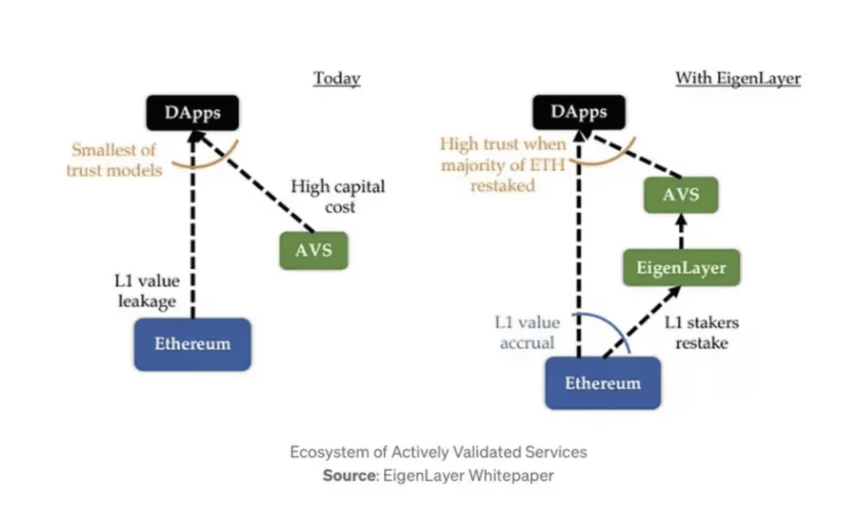
Notably, the Shanghai Upgrade, leading to the implementation of the EIP-4895. The latter played a major role in furthering the concept of restaking. This Ethereum EIP facilitated Beacon Chain staked ETH withdrawals. This added strength enabled users to be more independent with their assets.
Unpacking Ethereum restaking
Here is an easy way of understanding Ethereum restaking and how it works.
Imagine purchasing and assembling a massive versatile toolkit at home for fixing almost everything, from plumbing to electrical connections.
Having the toolkit at home is akin to Ethereum staking, whereas your committed ETH works as the toolkit, securing the Ethereum mainnet — your house.
Now, imagine letting your neighbors borrow this toolkit from you. This is with the pre-specified condition that you must have it whenever needed. This is what restaking means, as your all-powerful toolkit can help the neighborhood while you are in charge of its use.
Plus, the neighbors send you small tokens of appreciation every now and then, much like the re-staking rewards.

But what if your home (Ethereum network) becomes vulnerable now that the staking power or the toolkit is with others?
Even though the concerns are genuine, restaking protocols like EigenLayer have smart contracts in place to constantly monitor the usage of these tools and avoid over-commitment.
Consider this a tool-specific escrow service that only allows 50% of toolkit use at any given time, leaving 50% readily available for your home (Ethereum).
Why was Ethereum restaking needed?
Yes, an all-powerful toolkit is good to have. But nothing beats the feeling or the rewards associated with ensuring that this toolkit also helps others.
Restaking is a choice made by ETH holders to lend security to other protocols and maximize staking rewards in the process.
Did you know: For standard restaking, you need not have staked ETH or liquid staking tokens or receipts. If you have native ETH lying around, protocols like Ether.fi also allow direct re-staking, offering chances at higher rewards.
Economic implications of Ethereum restaking
Before we go deeper into the types of ETH restaking, it is important to understand how this relatively new concept impacts the price, future, and other elements related to the Ethereum mainnet.
For instance, as of September 2024, the restaking market is being led by the likes of EigenLayer and Pendle Finance, both having a significant decentralized finance (DeFi) presence.
If you simply look at the EigenLayer stats, it is evident that aggressive restaking is in play. Some custody options, like Lido, Rocket Pool, and Coinbase, are even more popular.
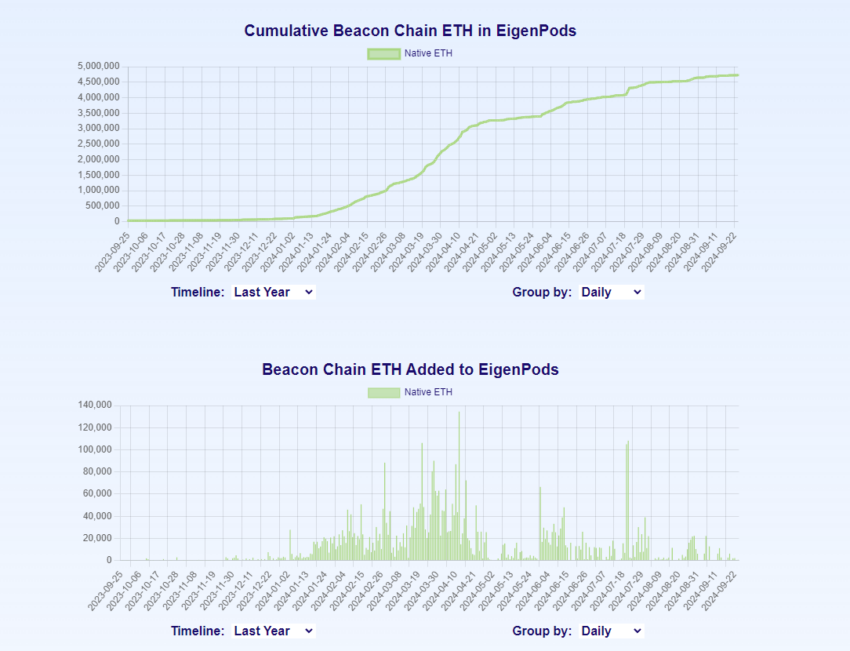
And it’s not just the liquid staking or the custody options that are seeing their staked ETH get restaked. Many Beacon chain ETH (native staked ETH) is also making it to the restaking protocols, primarily the EigenLayer.
As for the state of Ethereum, in terms of price action, Eigenlayer came into existence on June 14, 2023, and since then, the price action has been positive.
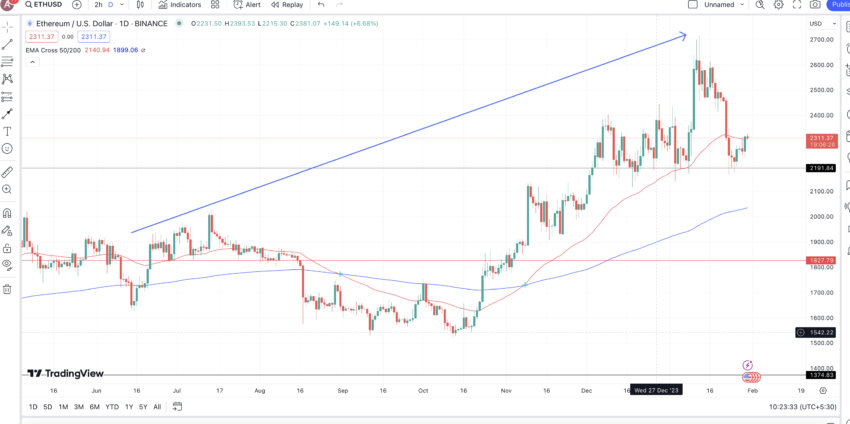
Surge in the popularity of restaking tokens
Eigenlayer is the pioneering restaking protocol. This restaking concept has been used by other players like Pendle Finance, which is using Ether.fi’s eETH — a liquid staking token — to facilitate restaking via Eigenlayer.

Similarly, Restake Finance is leveraging EigenLayer’s restaking concept to bring forth a product called Modular Liquid Restaking. Plus, there is Swell Finance, offering a native Liquid Restaking Token (LRT) to help you earn Eigerlayer points.
Exchange and info aggregators like CoinGecko now have a specific category termed restaking tokens. This shows how crucial the economic implications could be if this use case blows up even more aggressively.

Simply put, EigenLayer pioneers a liquid staking ecosystem with several players in the mix.
Type of Ethereum restaking
First of all, the restaking we are discussing is relevant to the EigenLayer concept. This is not the standard restaking where you can stake your liquid staking tokens across DeFi applications to generate yield.
Regarding Ethereum restaking via EigenLayer, you can either stake the native Beacon chain-staked ETH or stake already staked ETH on those popular liquid staking platforms.
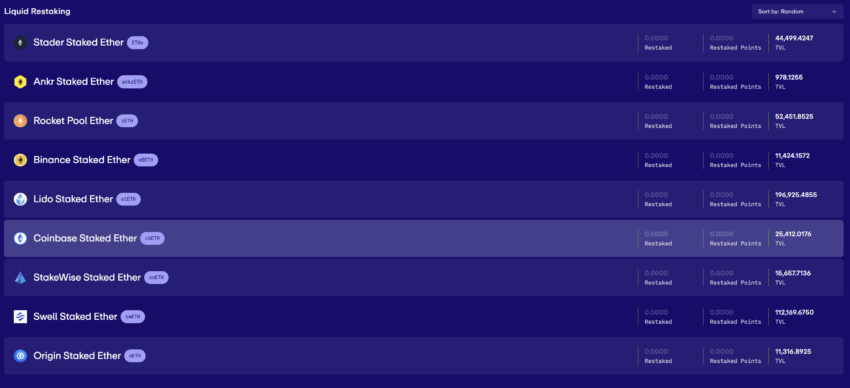
More experienced users can further explore the following options, which include native and liquid staking restaking along with the existing options:
- Native restaking: This is where validators use EigenLayer to restake the Beacon chain ETH, which is also staked by in the blocks of 32.
- Restaking LSDs: These are the receipt tokens that liquid staking solutions like Lido, Rocketpool, and more provide. EigenLayer also accepts the same.
- Restaking tokens from DeFi: Some validators prefer staking their wrapped ETH from DeFi, bringing an additional layer of rewards into the mix.
- ETH LP restaking: Finally, some validators can stake ETH on platforms like Lido, restake the stETH or the LSD token (LST token) on a DEX, and then re-re-stake the DEX-specific staked ETH token.
- Automatic restaking: Platforms like Ether.fi allows you to stake your ETH, with eETH as the liquid staking token. Plus, eETH is automatically integrated with the EigenLayer, which gets restaked without you having to head over to the EigenLayer interface separately.
If all that sounds a little confusing, here is a thread that explains it diagrammatically:
It is worth noting that EigenLayer, being the middleware, allows both Beacon chain ETH and liquid staking tokens, or the staked receipts of Ether, to be restaked.
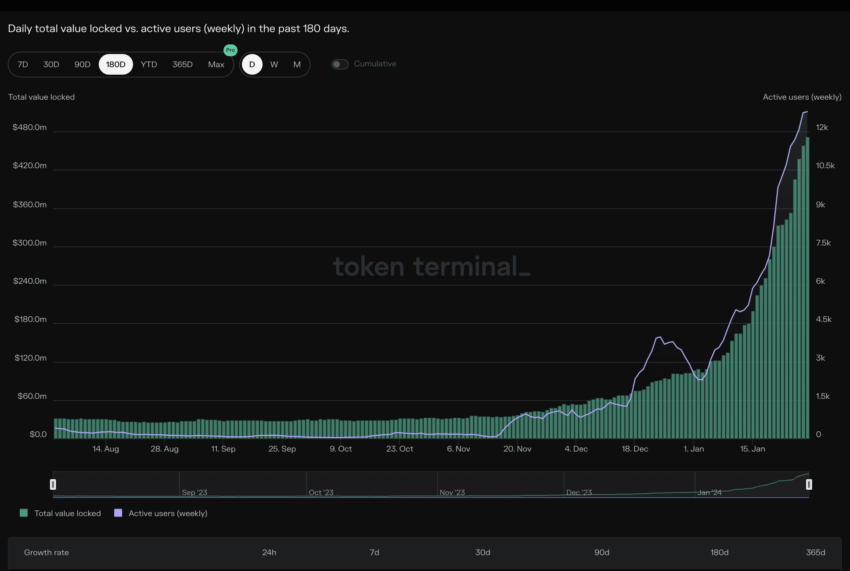
How to restake any ETH?
The first step is to choose how you want to stake your ETH in the first place. If you are loaded and more like a validator with 32 ETH locked into the Beacon Chain, you can head over to the EigenLayer interface and choose “restake” as the option.
Therefore, before learning about restaking, you should know how to stake Ethereum, as only staked ETH can be restaked via the EigenLayer.

The thing with Beacon Chain ETH is that while restaking, you need to create an Eigenpod — which is more like a repository of the staked ETH on the EigenLayer.
While restaking, you need to change the initially added validator withdrawal credentials — which is like the wallet address for withdrawing staked ETH and staked rewards — to the EigenPod credentials.
This way, the rewards and the ownership of the staked ETH are always with you and can be monitored at will. This would come in handy when you want to unstake the re-staked ETH.
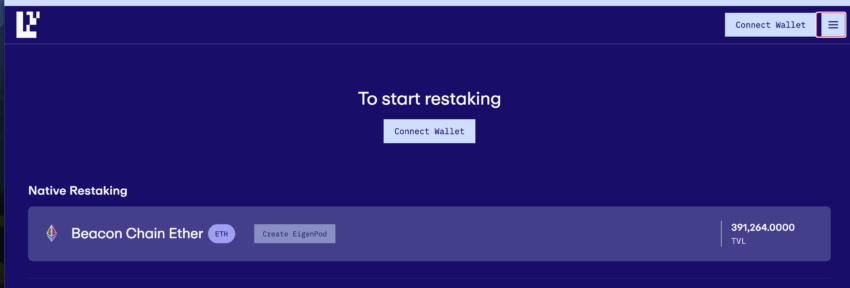
The second scenario involves you connecting with third-party solutions, like Liquid staking platforms, yield aggregators (Origin), non-custodial DeFi-specific yield generators (Swell protocol), and more.
Each platform allows you to natively stake ETH and get a staked token receipt, such as OETH, stETH, or anything else. These LSTs or DeFi-specific yield tokens with ETH as the underlying asset can be manually re-staked.
Benefits and challenges
| Potential benefits | Concerns and challenges |
|---|---|
| Compounding rewards allow stakers to earn additional, variable returns depending on AVS rates | Slashing risks increase if validators misbehave, varying by AVS standards. |
| Minimal startup costs for protocols using pooled security, reducing need for dedicated validators | Liquidity issues arise as restaked ETH may not be readily available for withdrawal. |
| Sovereign architecture lets protocols avoid layer-2 migration and related constraints | Complexity of managing LSTs and liquidity provider tokens creates high entry barriers |
| improved capital efficiency as more ETH stays on the mainnet, reducing gas fees | Security risks grow as moving security to other protocols could expose vulnerabilities |
How to benefit from ETH for EigenLayer restaking?
Restaking on EigenLayer will provide a unique experience for its actively validated services and Ethereum itself. One way to capitalize on this innovation is to anticipate the future growth in user experience and preemptively purchase ETH.
If you’re looking to buy Ethereum, here are a few platforms that offer secure and user-friendly interfaces to do just that.
Kraken
Since its inception, Kraken has grown to become one of the largest and most recognized cryptocurrency exchanges, gaining accolades for its diverse range of coins, solid security measures, and simple user interface. For those looking to prioritize safety and security when buying ETH, Kraken can be an option worth considering, thanks to its range of protective features, including 2FA (Google Authenticator and Yubikey), advanced cold storage and hot wallet solutions.
OKX
OKX distinguishes itself with its vast range of Bitcoin trading choices. It is appealing to both regular and institutional investors due to its wide feature set, which includes futures, options, spot, and derivative trading. With low fees and a user-friednly interface, OKX is a solid option for both beginners and advanced traders looking to buy ETH.
Wirex
Wirex was formed in 2014 by co-founders Pavel Matveev and Dmitry Lazarichev. Its initial foundation took place in the United Kingdom. Well known for its leading crypto card offerings, Wirex is a digital payment platform that combines money transfer, payment processing, and cryptocurrency exchange capabilities. Customers can easily convert traditional fiat currency to crypto using this platform. As such, Wirex offers a simple and user friendly vehicle for those looking to accumulate ETH.
Coinbase
Coinbase’s popularity stems from its user-friendly interface, strict adherence to rules, wide range of supported cryptocurrencies, stringent security procedures, extensive library of extra services, and comprehensive educational materials. Those looking to buy ETH with Coinbase will benefit from a straightforward process, as well as solid customer service and a transparent fee structure.
When can you unstake Ethereum?
Even though smart contracts power the EigenLayer, you need not interact with them directly for unstaking. To unstake restaked ETH, you first need to understand what kind of restaking route you want to take.
For EigenPod-based Beacon Chain restaking, you simply need to click on the “Unstake” tab or the amount of restaked ETH you want to release.

After that, you need to withdraw the validator access from the EigenPod, move it to your own wallet, and then wait for a seven-day escrow for the validator to exit the queue if you need to unstake all the ETH.
For a simple restaked ETH unstaking, withdrawing the validator access is enough.
For unstaking the Liquid Staking Tokens or the LP ETH tokens from EigenLayer, there is a direct unstake option beside the “Deposit” tab. Once you unstake, there is a progress tab. T
he same amount shows up as the withdrawable LST or LP ETH, depending on the rules set by the AVS EigenLayer in the first place.
Notably, there might be a lag between unstaking and withdrawal options, precisely designed to ensure the integrity and security of the associated protocols and networks.
In most cases, there is a seven-day Escrow period to consider for withdrawing the LST or LP ETH tokens to the participating wallet.
Meanwhile, other ecosystems are trying out different restaking narratives.
The road ahead for restaking and Ethereum
The concept of Ethereum restaking has rapidly gathered pace. Yet, most technically aligned users are more interested in the road ahead. With restaking expected to make AVS more powerful and reliable, Ethereum might be able to lead the development of new products.
These include financial products, novel consensus mechanisms, and data availability layers. The concept of pooled security could well be a game changer, helping reduce hacks and make the services more resilient.
Frequently asked questions
Can I lose money staking crypto?
What is the profit of ETH staking?
Is staking ETH a good idea?
Is staking Ethereum risk-free?
What is the safest way to stake ETH?
Is there risk in staking Ethereum?
How do I stake Ethereum myself?
Disclaimer
In line with the Trust Project guidelines, the educational content on this website is offered in good faith and for general information purposes only. BeInCrypto prioritizes providing high-quality information, taking the time to research and create informative content for readers. While partners may reward the company with commissions for placements in articles, these commissions do not influence the unbiased, honest, and helpful content creation process. Any action taken by the reader based on this information is strictly at their own risk. Please note that our Terms and Conditions, Privacy Policy, and Disclaimers have been updated.








